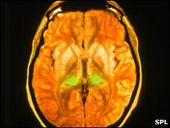
© SPLThere have been 168 definite or probable cases of vCJD in Britain
There have been 168 definite or probable cases of variant Creutzfeldt-Jakob disease (vCJD) since 1995.
Previous calculations had suggested thousands of people could be incubating the disease.
But the new research, in the
British Medical Journal, found no evidence of vCJD in 63,000 tonsil tissue samples.
The researchers said the results, reported in the
British Medical Journal, were "reassuring".
A government advisor said the study suggested that the number of future cases would be low.
There has been much debate over how many people in the population might be harbouring vCJD.
One team had extrapolated from the number of cases so far to predict around 200 further cases might be seen over coming decades.
But another small study of appendix and tonsil tissue had predicted a much higher level of cases - between 520 and 13,000.
The uncertainty led to the setting up of the National Anonymous Tissue Archive in 2004 so analysis could be carried out on a far bigger scale.
Eventually, the team from the Health Protection Agency and the National CJD Surveillance Unit will test 100,000 samples taken from people born between 1961 and 1995.
Researchers said based on the previous findings it was thought that up to 50 of the samples could contain the abnormal prion protein.
But so far they have found none.
Infected meat
Variant CJD or vCJD first emerged in 1995.
The disease, which affects the brain, is believed to have passed from cattle to humans through infected meat.
It causes personality change, loss of body function, and eventually death.
Although infected meat is no longer a risk, there has been continuing concern over human-to-human transmission through blood transfusions.
The researchers say they are still not be fully confident of the low levels of disease they found until they have completed analysis on all the samples.
And surveillance should continue in the future.
Study leader Dr Jonathan Clewley, an expert on vCJD at the HPA, said: "It may be that we have seen the worst of vCJD already, although we need to keep vigilant and implement appropriate public health measures to prevent any possible secondary spread of disease."
In an accompanying editorial Maurizio Pocchiari, a neurology expert based in Rome, said it was unlikely that no one in the UK was incubating the disease but that the small number of cases and diagnostic problems made accurate measurement difficult.
"Therefore, the precautionary measures already in place must be maintained to avoid transmission of vCJD between humans and surveillance of disease in the UK and in the rest of Europe should remain alive," he said.
Professor Christopher Higgins, chair of the Spongiform Encephalopathy Advisory Committee (SEAC), said the findings were indeed reassuring.
"The good news is this is a very widespread survey and a very well-conducted study."
"My guess is there are going to be a lot less cases than thought."

Reader Comments
to our Newsletter